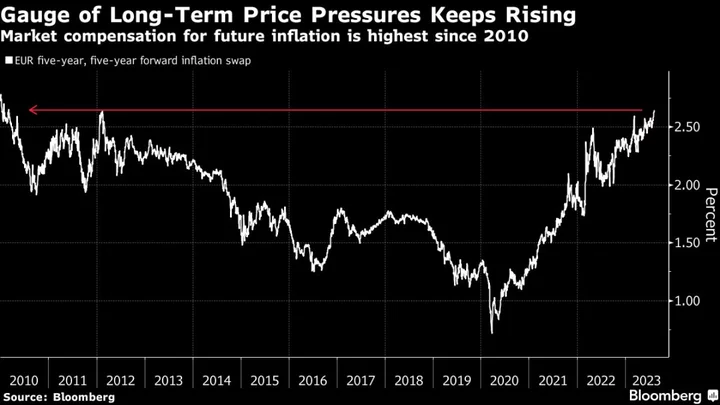Market measures of inflation risk in Europe are testing record highs and posing a challenge to European Central Bank officials as they eye the end of their historic tightening cycle.
A gauge of future inflation closed at its highest level since 2010 Monday, pointing to an average pace of 2.67% from 2028-2033. The move comes as yields on longer-maturity bonds climb faster than those on shorter notes, with investors demanding higher returns on assets that stretch far into the future to reflect the risk inflation stays elevated longer than expected.
It’s a potential headache for ECB officials, who will struggle to justify an end to interest-rate hikes if markets are betting on inflation staying above the central bank’s 2% target. It also stands in contrast to the US, where inflation expectations — albeit elevated — haven’t broken to new highs over the past year.
Gauges like inflation swaps and forecaster surveys are “key” for ECB rate setters, “and none of them are consistent with a pause in September,” said Piet Christiansen, chief strategist at Danske Bank A/S. “Inflation expectations are still concerning.”
Policymakers haven’t revealed whether they’re leaning toward a hike or a pause when they come back from their summer breaks, stressing that they’ll base their decision on the information available at the time. In their latest Governing Council meeting, they appeared to view risks to the inflation outlook as balanced, according to people familiar with the debate.
New projections are due in September that will reveal whether the ECB is any closer to reaching its 2% goal. In June, forecasts showed inflation would remain above the target all the way through 2025.
Still, ECB Chief Economist Philip Lane expressed confidence last week that the recent “rapid fall” in energy prices will bring down costs across the economy as well, so that “inflation should come down quite a lot later this year.”
That should also help lower inflation expectations. The ECB publishes a survey on consumers’ views later this morning.
Favorite Gauge
To be sure, a healthy dose of inflation is no bad thing for Europe. Consumer prices have languished well below the US rate for years, but that’s now changing and the outlook is gradually converging for the first time since 2009.
Technical factors are also at play. A supply and demand imbalance in the inflation-linked bond market and diminishing liquidity in August is supporting the latest leg higher, according to Antoine Gaveau, a strategist at Citi. More broadly, market pricing is a reflection of probability-weighted outcomes rather than investors’ base case.
Of the market-based gauges the ECB watches, the so-called five-year, five-year contract is one of its favorites because it isn’t skewed by expected price spikes over the immediate horizon. Such measures have rapidly repriced as monthly inflation prints repeatedly came in faster than expected over the last couple of years.
In the early months of the coronavirus pandemic, markets implied inflation would average below 1% in the second half of the coming decade. The pricing has climbed relentlessly since, even as some measures of current European inflation have eased in recent months. The ECB on Friday said the underlying pace of price growth the euro zone has probably peaked.
Still, the recent advance doesn’t suggest complete faith in the ECB’s ability to tame inflation long-term.
“Markets do not fully buy the ‘disinflation narrative,’” Mizuho rates strategist, Evelyne Gomez-Liechti, said.
--With assistance from Jana Randow.

